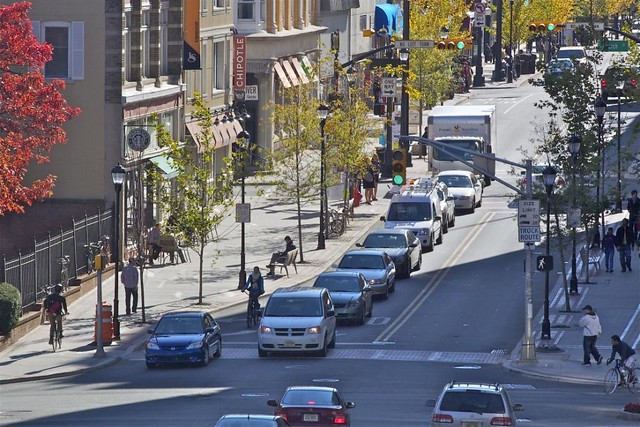
George Street, New Brunswick
Title 39 of the New Jersey Statutes Annotated (N.J.S.A.) covers motor vehicle law, as well as laws that govern highways in general (note: the definition of “highway” according to state law is different from the colloquial definition of the term – according to state law, virtually every public road and street that automobiles operate on, including city streets and side streets with low traffic volume, is considered to be a “highway”). Therefore, the vast majority of laws in the Statute that govern bicycle and pedestrian concerns are found in Title 39.
After the break are some of the most frequently asked questions asked about bicycle and pedestrian laws in New Jersey. The following Q&A intends to provide New Jersey roadway users with information about state bicycle and pedestrian laws. While most responses come directly from the New Jersey Permanent Statutes, some responses will come from regulations promulgated by other state, agencies including the New Jersey Department of Transportation (NJDOT) and NJ Transit.For more information on the laws click the “Read more” link to find out more about the pedestrian, bicyclist, and motorist responsibilities on the road in NJ!
Proposed Questions
Q: Are bicycles allowed on city streets? What about major roadways and highways?
A: Title 39:4-14.1 (Rights, duties of bicycle riders on roadways, exemptions) of the New Jersey Statute reads –
a. “Every person riding a bicycle upon a roadway shall be granted all of the rights and shall be subject to all of the duties applicable to the driver of a vehicle by chapter four of Title 39 of the Revised Statutes and all supplements thereto except as to those provisions thereof which by their nature can have no application.
Regulations applicable to bicycles shall apply whenever a bicycle is operated upon any highway or upon any path set aside for the exclusive use of bicycles subject to those exceptions stated herein.” This means that bicyclists must adhere to the same rules of the road that drivers do, including using turn signals, riding only on the right side of the road, and obeying traffic signals and signs.
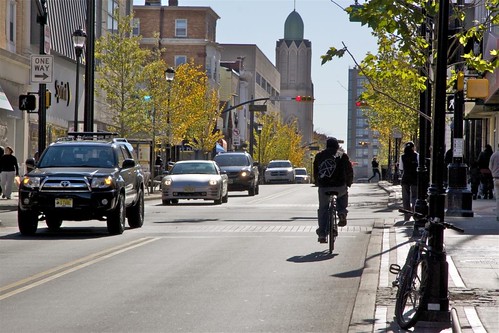
Cyclist riding properly in the roadway.
b. “A law enforcement officer operating a bicycle while in the performance of his duty, and who is engaged in the apprehension of violators of the law or of persons charged with, or suspected of, a violation shall not be subject to the provisions of this section.” The “exception to the rule,” bicycle-riding police officers may override traffic signs and signals in pursuit of a traffic violator or criminal suspect, or en route to an emergency.
“Roadway”, according to the New Jersey state law, refers to the improved part of a “highway” designed and used explicitly for vehicular travel, not including the shoulder. However, some roads (for example, limited-access highways such as the Turnpike) explicitly forbid non-motorized vehicles. This statute does not supersede such prohibitions. New Jersey Turnpike Authority Law § 19:9-1.9 (Limitations on use of Roadway) reads:
(a) Use of the [New Jersey Turnpike and Garden State Parkway] and entry thereon by the following, unless otherwise authorized by the Authority, is prohibited to:
1. Pedestrians;
2. Bicycles with or without motors and any other two or three-wheel vehicles, excluding motorcycles
Several non-interstate roadways throughout NJ also prohibit bicycles. A list of these roadways can be found on page 42 of the NJ Bicycling Manual. The manual also states that “Interstate roadways are currently closed to bicyclists; however, most sections are open by special permit issued by NJDOT.”
Q: Are bicycles allowed on sidewalks?
A: According to NJDOT, state law does not outlaw riding on the sidewalk, although some municipalities have passed ordinances that prohibit doing so. NJDOT also stresses that while riding on the sidewalk may not be illegal, it is not safe since sidewalks are mainly used by pedestrians. Bicycles are vehicles and belong in the street, with a notable exception made for small children. In locations where bicyclists do use the sidewalk, it is the bicyclists’ responsibility to yield to pedestrians.
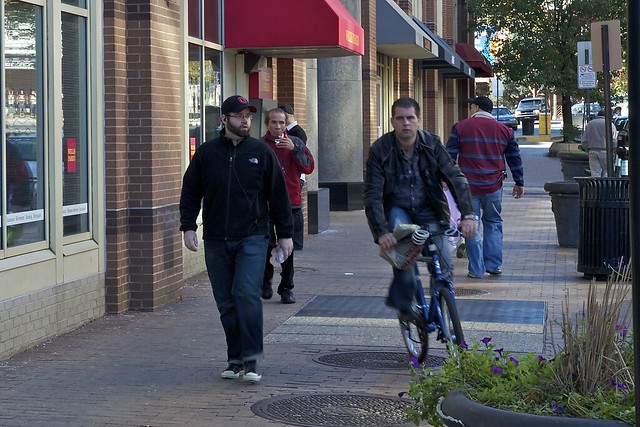
Riding on the sidewalk will often lead to conflicts with pedestrians
(Source: https://www.nj.gov/transportation/commuter/bike/faqs.shtm).
Q: What are the rules governing bicycles in traffic?
A: State Law 39:4-14.2 (Keeping to right; exceptions; single file) addresses this question –
Every person operating a bicycle upon a roadway shall ride as near to the right side of the roadway as practicable, exercising due care when passing a standing vehicle or one proceeding in the same direction; provided, however, that any person may move to the left under any of the following situations:
(a) to make a left turn from a left-turn lane or pocket;
(b) to avoid debris, drains or other hazardous conditions that make it impracticable to ride at the right side of the roadway;
(c) to pass a slower moving vehicle;
(d) to occupy any available lane when traveling at the same speed as other traffic;
(e) “to travel no more than two abreast when traffic is not impeded.” In other words, cyclists cannot ride with more than two alongside each other.
Persons riding bicycles upon a roadway may travel no more than two abreast when traffic is not impeded, but otherwise shall ride in single file except on paths or parts of roadways set aside for the exclusive use of bicycles
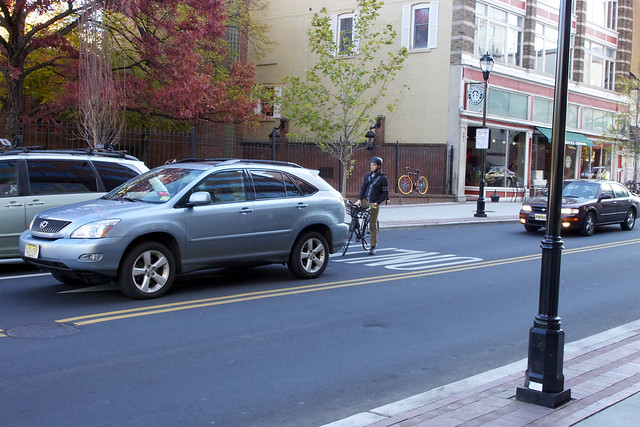
In this picture, the cyclist has moved into the left travel lane so as not to impede right turning traffic.
Q: Are bicycles required to have lights? What about horns?
A: The following is taken from New Jersey State Law 39:4-10 (Lights and reflectors on bicycles).
Every bicycle when in use at nighttime shall be equipped with a lamp on the front which shall emit a white light visible from a distance of at least five hundred feet to the front, and with a lamp on the rear which shall emit a red light visible from a distance of at least five hundred feet to the rear. In addition to the red lamp, a red reflector may be mounted on the rear, of a type approved by the division which shall be visible from all distances from fifty feet to three hundred feet to the rear when directly in front of lawful upper beams of head lamps on a motor vehicle.
Regarding horns or other audible warning devices, New Jersey State Law 39:4-11 (Audible signal) states –
“No person shall operate a bicycle unless it is equipped with a bell or other device capable of giving a signal audible for a distance of at least 100 feet, except that a bicycle shall not be equipped with nor shall any person use upon a bicycle any siren or whistle.” Sirens or whistles cannot be used on bicycles—bells are the only acceptable audible signals a bicycle can have.
Q: What are the helmet laws for cyclists in New Jersey?
A: New Jersey State Law 39:4-10.1 (Bicycle helmets, requirements) addresses this –
- a. “A person under 17 years of age shall not operate, or ride upon a bicycle as a passenger, unless that person is wearing a properly fitted and fastened bicycle helmet which meets the standards of the American National Standards Institute (ANSI Z90.4 bicycle helmet standard) or the Snell Memorial Foundation’s 1990 Standard for Protective Headgear for Use in Bicycling. This requirement shall apply to a person who rides upon a bicycle while in a restraining seat which is attached to the bicycle or in a trailer towed by the bicycle.” Cyclists 17 years of age or younger must use an approved bicycle helmet when riding a bicycle.
c. [This requirement]shall apply at all times while a bicycle is being operated on any property open to the public or used by the public for pedestrian and vehicular purposes; however, a municipality may by ordinance exempt from this requirement a person operating or riding on a bicycle as a passenger when the bicycle is operated:
(1) on a road or highway closed to motor vehicle traffic and limited to pedestrian or bicycle use at all times or only during specified periods of time during which bicycles may be operated; or
(2) exclusively on a trail, route, course, boardwalk, path or other area which is set aside for the use of bicycles or for the use of pedestrians and bicycle operation is not otherwise prohibited. However, an exemption may not be granted under this paragraph for any portion of a trail, route, course, boardwalk, path or other area which is immediately adjacent to a road or highway used by motor vehicle traffic and which does not contain a barrier of sufficient height and rigidity to prevent the inadvertent or deliberate entry of a bicycle operator onto the road or highway.
Another clause in this subsection also requires businesses who rent bicycles to provide helmets for those under age 17, and for those who sell or rent bicycles to place signs on their bicycles informing them that state law requires helmets for persons under the age of 17. Violators of the helmet law will receive warnings for their first offense. Since only minors are bound to the restrictions in the law, the parent or legal guardian may be fined a maximum of $25 for the 1st offense (after a warning has been issued) and a maximum of $100 for subsequent offense(s), if lack of parental supervision contributed to the offense.
Q: Are bicycles allowed on New Jersey Transit trains and buses?
A: NJ Transit allows collapsible bicycles on all of its trains at any time. However, standard bicycles and Segways are prohibited during certain times and on certain trains. The special rules governing NJ Transit’s policy with regards to standard bicycles and Segways are as follows:
- A bicycle or Segway™ may not be brought on board a NJ Transit train bound for Hoboken, Newark, or New York (basically, all eastbound trains) between 6:00 AM and 10:00 AM on a weekday (Monday through Friday).
- A bicycle or Segway™ may not be brought on board a NJ Transit train originating in Hoboken, Newark, or New York (all westbound trains) between the hours of 4:00 and 7:00 PM.
- A bicycle or Segway™ is not permitted on board during major holidays: New Year’s Day, Memorial Day, Independence Day, Labor Day, Thanksgiving, and Christmas Day.
- A bicycle or Segway™ is not permitted on board a NJ Transit train on the day prior to the aforementioned holidays, the Friday after Thanksgiving, or the day before Yom Kippur or Rosh Hashanah.
- A bicycle or Segway™ may not board or alight at any station with a low-level platform, such as Hoboken.
- A bicycle or Segway™ must be kept in the accessible area of your rail car. Only two bicycles or two Segway™ vehicles can be accommodated at a time in each car. If space is not available, cyclists or Segway users must wait for the next available train. If a person with a disability requests the accessible space, a cyclist or Segway™ user must walk on the platform to another car or detrain and wait for the next available train.
- Tiedowns are recommended and bicycles or Segway™ vehicles should be secured in the manner depicted on the diagram at that location. The cyclist or Segway™ user must hold and steady a bicycle or Segway™ that is not secured by tiedowns. The kickstand of the bicycle must remain up at all times.
It’s important to note that all bicycles (both collapsible and standard-frame), as well as Segway™ vehicles are permitted on the Atlantic City Rail Line at all times.
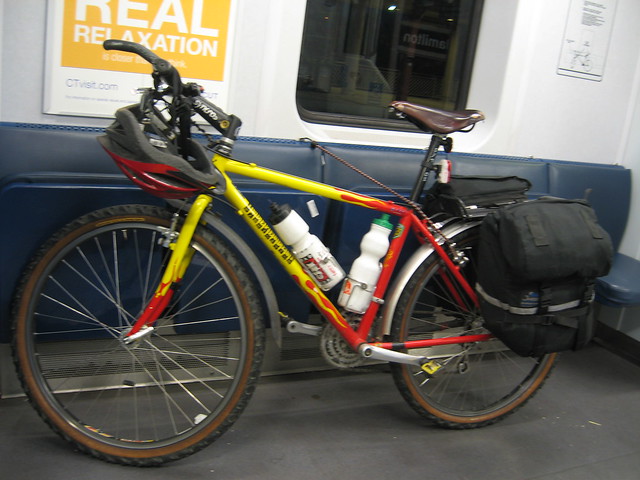
Bicycles, such as this one are permitted on NJ Transit trains provided passengers alight at high-level platforms outside peak travel periods. Note the proper use of tiedowns.
(Source: https://www.njtransit.com/rg/rg_servlet.srv?hdnPageAction=BikeProgramTo)
Q: What are the laws regarding children and bicycles in New Jersey?
A: Children under the age of 17 are required by state law to wear a helmet. While adults are generally discouraged (and in some municipalities, banned) from riding on the sidewalk, young children learning how to ride a bike are allowed on the sidewalk. Parents may be held responsible for their child if s/he does not obey bicycle laws.
Q: What is the law now regarding pedestrians in the crosswalk?
A: The New Jersey Division of Highway Traffic Safety (DHTS) says that as of April 1, 2011, drivers must STOP (and stay stopped) if a pedestrian is walking within a marked crosswalk. Crosswalks can be marked or unmarked (painted lines or nothing at all), but regardless of road markings, any intersection is considered a legal crosswalk. Crosswalks can also be signalized or unsignalized, or at the end of a block or mid-block. Unmarked crosswalks are typically located between the edge of a sidewalk on one corner of a street and the edge of the sidewalk on a corner on the opposite end of the street – basically where a crosswalk would be if it were marked. This also applies to “T” intersections where there may not be an opposing center. The new law only requires drivers to come to a complete stop for pedestrians in marked crosswalks, however. The old law only required drivers to yield to pedestrians.
Failure by a motorist to stop and stay stopped for a pedestrian who is within a crosswalk may be subject to one or more of the following penalties.
- 2 point applied to your NJ Drivers’ license
- $200 fine (plus court fees)
- 15 days community service
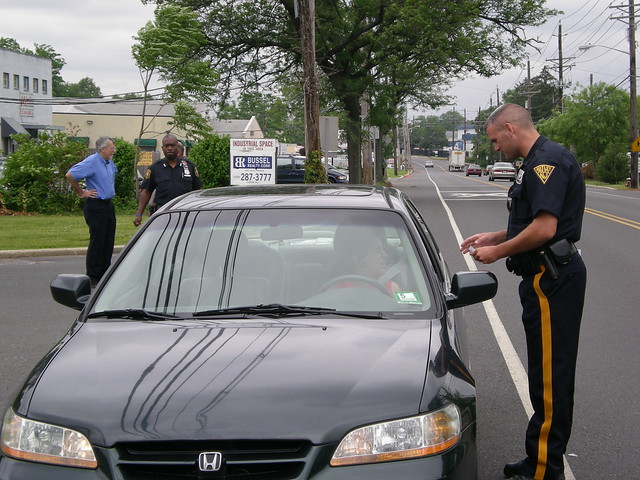
Fines of up to $200 will be issued for failure to STOP for a pedestrian in a crosswalk
(Source: https://www.nj.gov/lps/hts/pedestrian.html)
Q: What are motorists’ responsibilities? What are pedestrians’ responsibilities?
A: According to DHTS, motorists must remain vigilant and aware of pedestrians, cyclists, and other motorists at all times. They must obey all traffic laws and be particularly aware of pedestrians while making turns or at signalized intersections. They should keep their windshields clear in order to increase visibility as much as possible and keep in mind pedestrians will be especially difficult to spot at night or in adverse weather conditions, such as rain, snow, or ice.
Pedestrians should keep in mind that although it is the law for motorists to come to a stop while they are crossing a marked crosswalk, they should expect the unexpected and watch out for motorists breaking the law. Pedestrians should use marked and signalized crosswalks whenever possible. Pedestrians should look left first, then right, and left again before crossing a street. Pedestrians who fail to utilize a crosswalk or fail to obey pedestrian signals may result in a fine of up to $54.00 for failure to observe the law.
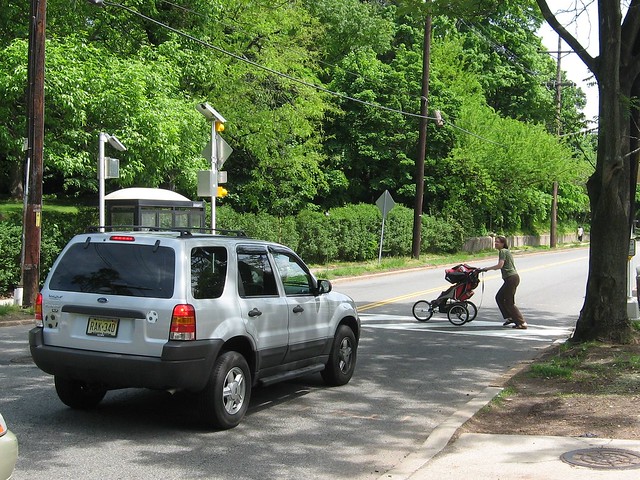
Pedestrians should use crosswalks whenever possible, and can face fines for improper crossing.
(Source: https://www.nj.gov/lps/hts/pedestrian.html)
Q: What are pedestrians NOT allowed to do?
A: For state law governing pedestrian movements, we turn to Title 39:4-32 (Crossing roadway; signal). It reads as follows –
On highways where traffic is controlled by a traffic control signal or by traffic or police officers:
a. “Pedestrians shall not cross a roadway against the “stop” or red signal at a crosswalk, whether marked or unmarked, unless otherwise specifically directed to go by a traffic or police officer, or official traffic control device. “ This means that unless a police officer directs a pedestrian to do otherwise, pedestrians may only cross when the light is green or the pedestrian “WALK” signal is displayed.
d. “No pedestrian shall leave a curb or other place of safety and walk or run into the path of a vehicle which is so close that it is impossible for the driver to yield or stop.” This means: “Don’t run recklessly into traffic.”
f. “Every pedestrian upon a roadway at any point other than a marked crosswalk or within an unmarked crosswalk at an intersection shall yield the right-of-way to all vehicles upon the roadway.” Other than crosswalks, vehicles have the right-of-way and pedestrians should not expect motorists to stop for them. Cross at crosswalks whenever possible; if this is not possible, pedestrians need to exercise extreme caution when crossing.
g. “Nothing herein shall relieve a pedestrian from using due care for his safety.” A pedestrian is responsible for his/her own behavior by obeying traffic laws, being attentive to his/her surroundings, and only crossing when and where it is appropriate.
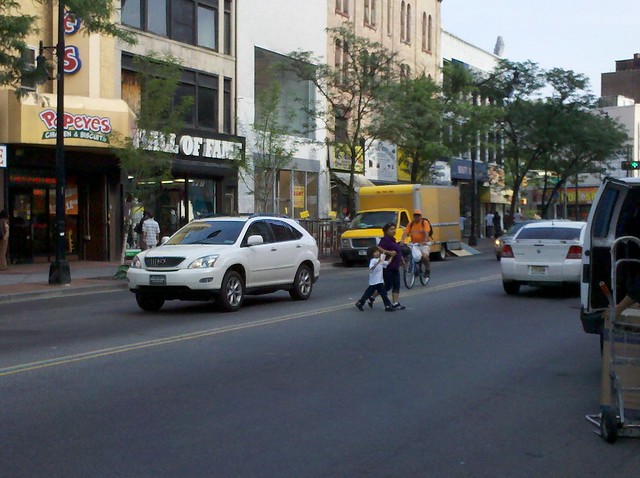
Crossing at unmarked mid-block locations is not recommended
The next subsections, 39:4-33. (Use of designated crosswalk; keeping to right) and 39:4-34 (Pedestrians to cross within crosswalk or at right angles; facing traffic; sidewalks), discuss requirements for pedestrians.
“39:4-33. At intersections where traffic is directed by a police officer or traffic signal, no pedestrian shall enter upon or cross the highway at a point other than a crosswalk. Pedestrians shall move, whenever practicable, upon the right half of crosswalks.” Pedestrians may only use crosswalks to cross the street.
“39:4-34. Where traffic is not controlled and directed either by a police officer or a traffic control signal, pedestrians shall cross the roadway within a crosswalk or, in the absence of a crosswalk, and where not otherwise prohibited, at right angles to the roadway. It shall be unlawful for a pedestrian to cross any highway having roadways separated by a medial barrier, except where provision is made for pedestrian crossing. On all highways where there are no sidewalks or paths provided for pedestrian use, pedestrians shall, when practicable, walk only on the extreme left side of the roadway or its shoulder facing approaching traffic. Where sidewalks are provided it shall be unlawful for any pedestrian to walk along and upon an adjacent roadway.” Pedestrians are required to use sidewalks where they are available. When there is no sidewalk, pedestrians must travel on the left side of the road so they are able to see oncoming traffic.
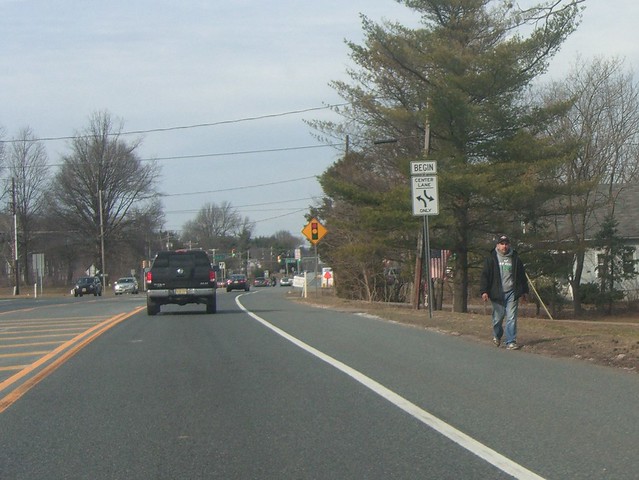
When no sidewalk is available, pedestrians should always walk facing traffic
Conclusions
No matter where you are, where you’re going, or what mode of travel you use to get there, safety and responsibility are of the utmost importance. Pedestrians, cyclists, and motorists are all responsible for knowing road use laws and obeying them in order to share the road effectively. In a densely populated state like New Jersey this becomes even more critical. Let’s all do our part to make New Jersey a safe place to walk and ride.
